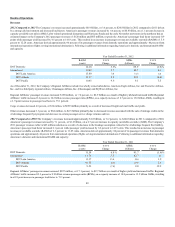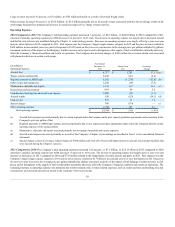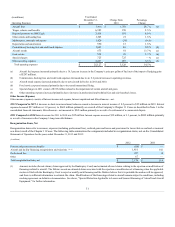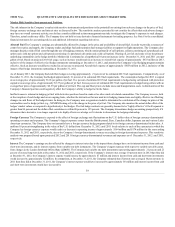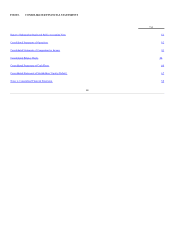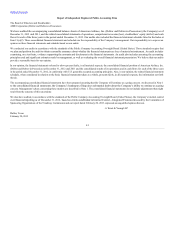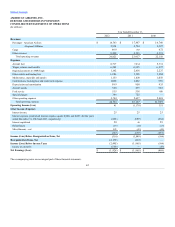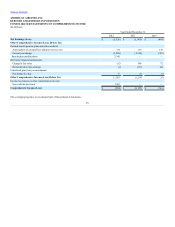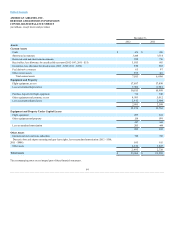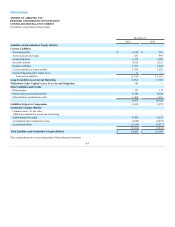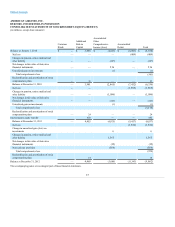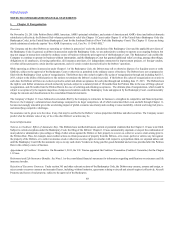American Airlines 2012 Annual Report Download - page 58
Download and view the complete annual report
Please find page 58 of the 2012 American Airlines annual report below. You can navigate through the pages in the report by either clicking on the pages listed below, or by using the keyword search tool below to find specific information within the annual report.
ITEM 7(A). QUANTITATIVE AND QUALITATIVE DISCLOSURES ABOUT MARKET RISK
Market Risk Sensitive Instruments and Positions
The risk inherent in the Company’s market risk sensitive instruments and positions is the potential loss arising from adverse changes in the price of fuel,
foreign currency exchange rates and interest rates as discussed below. The sensitivity analyses presented do not consider the effects that such adverse changes
may have on overall economic activity, nor do they consider additional actions management may take to mitigate the Company’s exposure to such changes.
Therefore, actual results may differ. The Company does not hold or issue derivative financial instruments for trading purposes. See Note 8 to the consolidated
financial statements for accounting policies and additional information regarding derivatives.
Aircraft Fuel The Company’s earnings are substantially affected by changes in the price and availability of aircraft fuel. In order to provide a measure of
control over price and supply, the Company trades and ships fuel and maintains fuel storage facilities to support its flight operations. The Company also
manages the price risk of fuel costs through the use of hedging contracts, which consist primarily of call options, collars (consisting of a purchased call
option and a sold put option) and call spreads (consisting of a purchased call option and a sold call option). Heating oil, jet fuel and crude oil are the primary
underlying commodities in the hedge portfolio. Market risk is estimated as a hypothetical 10 percent increase in the December 31, 2012 and 2011 cost per
gallon of fuel. Based on projected 2013 fuel usage, such an increase would result in an increase to Aircraft fuel expense of approximately $633 million in 2013,
inclusive of the impact of effective fuel hedge instruments outstanding at December 31, 2012, and assumes the Company’s fuel hedging program remains
effective. Such an increase would have resulted in an increase to projected Aircraft fuel expense of approximately $658 million in 2012, inclusive of the
impact of fuel hedge instruments outstanding at December 31, 2011.
As of January 2013, the Company had cash flow hedges covering approximately 21 percent of its estimated 2013 fuel requirements. Comparatively, as of
December 31, 2011, the Company had hedged approximately 21 percent of its estimated 2012 fuel requirements. The consumption hedged for 2013 is capped
at an average price of approximately $3.03 per gallon of jet fuel. Five percent of estimated 2013 fuel requirements is hedged using call spreads with protection
capped at an average price of approximately $3.37 per gallon of jet fuel. Sixteen percent of estimated 2013 fuel requirements is hedged using collars with an
average floor price of approximately $2.39 per gallon of jet fuel. The cap and floor prices exclude taxes and transportation costs. A deterioration of the
Company’s financial position could negatively affect the Company’s ability to hedge fuel in the future.
Ineffectiveness is inherent in hedging jet fuel with derivative positions based in crude oil or other crude oil related commodities. The Company assesses, both
at the inception of each hedge and on an ongoing basis, whether the derivatives that are used in its hedging transactions are highly effective in offsetting
changes in cash flows of the hedged items. In doing so, the Company uses a regression model to determine the correlation of the change in prices of the
commodities used to hedge jet fuel (e.g., NYMEX Heating oil) to the change in the price of jet fuel. The Company also monitors the actual dollar offset of the
hedges’ market values as compared to hypothetical jet fuel hedges. The fuel hedge contracts are generally deemed to be “highly effective” if the R-squared is
greater than 80 percent and the dollar offset correlation is within 80 percent to 125 percent. The Company discontinues hedge accounting prospectively if it
determines that a derivative is no longer expected to be highly effective as a hedge or if it decides to discontinue the hedging relationship.
Foreign Currency The Company is exposed to the effect of foreign exchange rate fluctuations on the U.S. dollar value of foreign currency-denominated
operating revenues and expenses. The Company’s largest exposure comes from the British pound, Euro, Canadian dollar, Japanese yen and various Latin
American currencies. The Company does not currently have a foreign currency hedge program related to its foreign currency-denominated ticket sales. A
uniform 10 percent strengthening in the value of the U.S. dollar from December 31, 2012 and 2011 levels relative to each of the currencies in which the
Company has foreign currency exposure would result in a decrease in operating income of approximately $164 million and $174 million for the years ending
December 31, 2012 and 2011, respectively, due to the Company’s foreign-denominated revenues exceeding its foreign-denominated expenses. This sensitivity
analysis was prepared based upon projected 2012 and 2011 foreign currency-denominated revenues and expenses as of December 31, 2012 and 2011,
respectively.
Interest The Company’s earnings are also affected by changes in interest rates due to the impact those changes have on its interest income from cash and
short-term investments, and its interest expense from variable-rate debt instruments. The Company’s largest exposure with respect to variable rate debt comes
from changes in the London Interbank Offered Rate (LIBOR). The Company had variable rate debt instruments representing approximately 21 percent and 21
percent of its total long-term debt at December 31, 2012 and 2011, respectively. If the Company’s interest rates average 10 percent more in 2012 than they did
at December 31, 2012, the Company’s interest expense would increase by approximately $7 million and interest income from cash and short-term investments
would increase by approximately $2 million. In comparison, at December 31, 2011, the Company estimated that if interest rates averaged 10 percent more in
2011 than they did at December 31, 2011, the Company’s interest expense would have increased by approximately $6 million and interest income from cash
and short-term investments would have increased by
58



